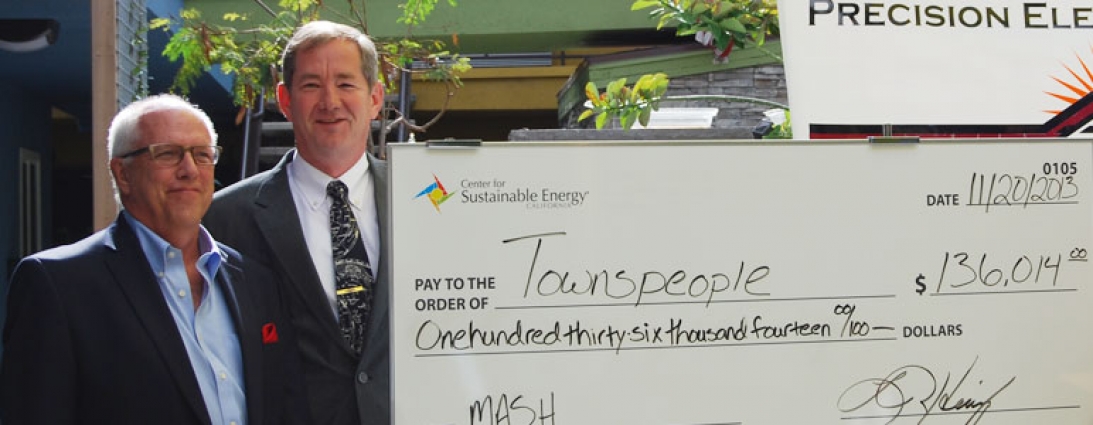

MASH program brought 2.6 MW of solar & $10 million in rebates
The final project in a program that has provided 2.6 megawatts of clean solar power to low-income San Diegans was dedicated during ceremonies at the Townspeople Apartments in Normal Heights on Wednesday, Nov. 20.
The 34-unit Townspeople Apartments recently installed a 58-kilowatt solar photovoltaic (PV) system with financial assistance from the California Solar Initiative’s Multifamily Affordable Solar Housing (MASH) Program. During the dedication event, CCSE presented Townspeople Inc. with a rebate check from the MASH program for $136,014. CCSE administrates MASH in the SDG&E territory.
The Townspeople solar PV system will benefit residents by lowering their utility costs by approximately $290 a year per apartment. By substituting solar for conventional electricity, the residents will lower their carbon footprint, offsetting some 136,460 pounds of carbon dioxide annually, equivalent to removing the greenhouse gas emissions of 25,790 cars annually. Precision Electrical Co. of San Diego installed the solar system.
“Making solar technologies available to residents of all income levels is a crucial part of the California Solar Initiative and the overall growth of the solar industry in California,” said Len Hering, RADM, USN (ret.), CCSE executive director. “Low-income housing developments traditionally have not had the resources to obtain solar, but the MASH Program, combined with other government and utility support and some creative financing options have successfully cracked the major barriers of high up-front costs and lack of access to capital.”
Five years of local successes
Since its inception in 2009, the MASH Program has awarded and reserved $95 million in rebates for more than 402 solar PV projects throughout the state, delivering some 30.6 megawatts of electricity for low-income residents. The San Diego portion is $10 million for 41 projects yielding 2.6 megawatts of power, according to CCSE officials.
Among the San Diego low-income apartments that have taken advantage of the MASH Program are the 107-unit Las Serenas Apartments in National City operated by Community HousingWorks, the 52-unit Hacienda Townhomes in San Diego East Village operated by San Diego Community Housing Corporation and the 49-unit Village Place operated by Father Joe’s Villages, also in the East Village.
The MASH Program got off to a slow start, but eventually activity improved significantly, thanks in large part to the introduction of third-party financing such as power purchase agreements (PPAs) and solar leases. Third-party providers were able to leverage the MASH incentives and federal tax benefits to offer competitively priced contracts to building owners, often nonprofit organizations.
Proved concept of virtual net metering
The MASH program also got a boost from the acceptance of an electrical metering technology, called “virtual” net metering. This allows the electricity generated from a single PV system to flow directly onto the grid and subsequently, the utility assigns energy credits across multiple tenant and building owner electric service accounts at one site. Previously, net energy metering required a separate meter for each PV system, which greatly increases overall project costs and is a barrier to PV development in multitenant settings.
The MASH Program proved the concept of virtual net metering, and in a decision issued in July 2011, the California Public Utilities Commission broadened the scope to include all multimeter residential, commercial and industrial properties, regardless of whether or not the customer received a state incentive. Multifamily affordable housing property owners that invest in solar PV are able to utilize virtual net metering tariffs even if they are not able to participate in the MASH Program.
Low-income solar coming back
While funds for MASH Program projects in San Diego have ran out and the program is set to end in 2016, recent legislation (Assembly Bill 217) will revive the rebates next year by extending the program and the closely related Single-Family Affordable Solar Homes Program to the end of 2021. The legislation, signed by Governor Jerry Brown in early October, earmarks $108 million for additional rebates for the two programs with the goal of adding 50 megawatts of new solar generation. It also sets up a program to help train California residents to learn about solar technology and prepare for jobs in the solar industry.
“Part of what makes California’s low-income solar programs so impactful is that participants on all levels have managed to achieve not only energy savings and environmental benefits, but also achieve some financial gain,” Hering said. “While some other states and municipalities have programs similar to MASH, once again California leads the way in getting clean, renewable energy to people of all income levels and living circumstances.”
